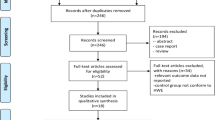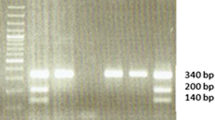Abstract
Epidemiological studies have evaluated the association between 3801T>C and 2455A>G polymorphisms of cytochrome P450 1A1 (CYP1A1) and prostate cancer risk. However, controversy exists regarding the role of these polymorphisms. In this work, a meta-analysis was performed to derive a more precise estimation of the relationship. PubMed and ISI Web databases were searched for all cases dated until March 2012. Crude odds ratios with 95 % confidence intervals were used to assess the strength of the association between CYP1A1 polymorphisms and prostate cancer risk. Sensitivity analysis, excluding the studies that deviated from the Hardy–Weinberg equilibrium (HWE), was performed. A total of 17 studies fulfilled our inclusion criteria in this meta-analysis, 12 of which were eligible (1,645 cases and 1,801 controls) for 3801T>C, and eleven (1,640 cases and 1,959 controls) were eligible for 2455A>G. Overall, the 2455A>G polymorphism resulted in a significantly increased susceptibility to prostate cancer. In addition, no significant associations between 3801T>C polymorphism and prostate cancer susceptibility were found in all genetic models. Only an elevated risk was observed for TC versus CC in Asian studies. However, no relationship was found in the Asian group for TC versus CC after excluding the studies that deviated from HWE. Thus, this meta-analysis finds the 2455A>G allele to be a risk factor for prostate cancer, whereas the 3801T>C status does not seem to be capable of modifying prostate cancer risk.






Similar content being viewed by others
References
Nakagawa H, Akamatsu S, Takata R, Takahashi A, Kubo Mi, Nakamura Y (2012) Prostate cancer genomics, biology, and risk assessment through genome-wide association studies. Cancer Sci 103(4):607–613. doi:10.1111/j.1349-7006.2011.02193.x
Boyle P, Severi G, Giles GG (2003) The epidemiology of prostate cancer. Urol Clin North Am 30(2):209–217
Schaid DJ (2004) The complex genetic epidemiology of prostate cancer. Hum Mol Genet 13:R103–R121
Coughlin SS, Hall IJ (2002) A review of genetic polymorphisms and prostate cancer risk. Ann Epidemiol 12(3):182–196
Crofts F, Taioli E, Trachman J, Cosma GN, Currie D, Toniolo P, Garte SJ (1994) Functional significance of different human CYP1A1 genotypes. Carcinogenesis 15(12):2961–2963
Nebert DW, McKinnon RA, Puga A (1996) Human drug–metabolizing enzyme polymorphisms: effects on risk of toxicity and cancer. DNA Cell Biol 15(4):273–280
Crofts F, Cosma GN, Currie D, Taioli E, Toniolo P, Garte SJ (1993) A novel CYP1A1 gene polymorphism in African-Americans. Carcinogenesis 14(9):1729–1731
Shah PP, Saurabh K, Pant MC, Mathur N, Parmar D (2009) Evidence for increased cytochrome P450 1A1 expression in blood lymphocytes of lung cancer patients. Mutat Res 670(1–2):74–78
Agundez JA (2004) Cytochrome P450 gene polymorphism and cancer. Curr Drug Metab 5(3):211–224
Sterling KM, Cutroneo KR (2004) Constitutive and inducible expression of cytochromes P4501A (CYP1A1 and CYP1A2) in normal prostate and prostate cancer cells. J Cell Biochem 91(2):423–429
Shaik AP, Jamil K, Das P (2009) CYP1A1 polymorphisms and risk of prostate cancer: a meta-analysis. Urol J 6(2):78–86
Liu JB, Li M, Chen H, Zhong SQ, Yang S, Du WD, Hao JH, Zhang TS, Zhang XJ, Zeegers MP (2007) Association of vitiligo with HLA-A2: a meta-analysis. J Eur Acad Dermatol Venereol 21(2):205–213. doi:10.1111/j.1468-3083.2006.01899.x
Gao LB, Pan XM, Li LJ, Liang WB, Zhu Y, Zhang LS, Wei YG, Tang M, Zhang L (2011) RAD51 135G/C polymorphism and breast cancer risk: a meta-analysis from 21 studies. Breast Cancer Res Treat 125(3):827–835
Thakkinstian A, McElduff P, DEste C, Duffy D, Attia J (2005) A method for meta-analysis of molecular association studies. Stat Med 24(9):1291–1306. doi:10.1002/sim.2010
Friedrich JO, Adhikari NK, Beyene J (2007) Inclusion of zero total event trials in meta-analyses maintains analytic consistency and incorporates all available data. BMC Med Res Methodol 7(1):5. doi:10.1186/1471-2288-7-5
Higgins JP, Thompson SG, Deeks JJ, Altman DG (2003) Measuring inconsistency in meta-analyses. BMJ 327(7414):557–560
Mantel N, Haenszel W (1959) Statistical aspects of the analysis of data from retrospective studies of disease. J Natl Cancer Inst 22(4):719–748
Egger M, Davey SG, Schneider M, Minder C (1997) Bias in meta-analysis detected by a simple, graphical test. BMJ 315(7109):629–634
Rohlfs RV, Weir BS (2008) Distributions of Hardy–Weinberg equilibrium test statistics. Genetics 180(3):1609–1616. doi:10.1534/genetics.108.088005
Quinones LA, Irarrazabal CE, Rojas CR, Orellana CE, Acevedo C, Huidobro C, Varela NE, Caceres DD (2006) Joint effect among p53, CYP1A1, GSTM1 polymorphism combinations and smoking on prostate cancer risk: an exploratory genotype–environment interaction study. Asian J Androl 8(3):349–355. doi:10.1111/j.1745-7262.2006.00135.x
Caceres D, Iturrieta J, Acevedo C, Huidobro C, Varela N, Escala M, Quinones L (2004) Gene–gene and gene–environment interactions as modifier factors of prostatic cancer risk: “a case-only” design study. Rev Med Chil 132(8):961–970
Acevedo C, Opazo JL, Huidobro C, Cabezas J, Iturrieta J, Sepulveda QL (2003) Positive correlation between single or combined genotypes of CYP1A1 and GSTM1 in relation to prostate cancer in Chilean people. Prostate 57(2):111–117. doi:10.1002/pros.10274
Murata M, Shiraishi T, Fukutome K, Watanabe M, Nagao M, Kubota Y, Ito H, Kawamura J, Yatani R (1998) Cytochrome P4501A1 and glutathione S-transferase M1 genotypes as risk factors for prostate cancer in Japan. Jpn J Clin Oncol 28(11):657–660
Caceres DD, Iturrieta J, Acevedo C, Huidobro C, Varela N, Quinones L (2005) Relationship among metabolizing genes, smoking and alcohol used as modifier factors on prostate cancer risk: exploring some gene–gene and gene–environment interactions. Eur J Epidemiol 20(1):79–88
Murata M, Watanabe M, Yamanaka M, Kubota Y, Ito H, Nagao M, Katoh T, Kamataki T, Kawamura J, Yatani R, Shiraishi T (2001) Genetic polymorphisms in cytochrome P450 (CYP) 1A1, CYP1A2, CYP2E1, glutathione S-transferase (GST) M1 and GSTT1 and susceptibility to prostate cancer in the Japanese population. Cancer Lett 165(2):171–177
Koutros S, Berndt SI, Sinha R, Ma X, Chatterjee N, Alavanja MC, Zheng T, Huang WY, Hayes RB, Cross AJ (2009) Xenobiotic metabolizing gene variants, dietary heterocyclic amine intake, and risk of prostate cancer. Cancer Res 69(5):1877–1884
Berndt SI, Chatterjee N, Huang WY, Chanock SJ, Welch R, Crawford ED, Hayes RB (2007) Variant in sex hormone-binding globulin gene and the risk of prostate cancer. Cancer Epidemiol Biomarkers Prev 16(1):165–168
Nock NL, Liu X, Cicek MS, Li L, Macarie F, Rybicki BA, Plummer SJ, Maclennan GT, Casey G, Witte JS (2006) Polymorphisms in polycyclic aromatic hydrocarbon metabolism and conjugation genes, interactions with smoking and prostate cancer risk. Cancer Epidemiol Biomarkers Prev 15(4):756–761
Figer A, Friedman T, Manguoglu AE, Flex D, Vazina A, Novikov I, Shtrieker A, Sidi AA, Tichler T, Sapir EE, Baniel J, Friedman E (2003) Analysis of polymorphic patterns in candidate genes in Israeli patients with prostate cancer. Isr Med Assoc J 5(10):741–745
Beuten J, Gelfond JA, Franke JL, Weldon KS, Crandall AC, Johnson-Pais TL, Thompson IM, Leach RJ (2009) Single and multigenic analysis of the association between variants in 12 steroid hormone metabolism genes and risk of prostate cancer. Cancer Epidemiol Biomarkers Prev 18(6):1869–1880
Cunningham JM, Hebbring SJ, McDonnell SK, Cicek MS, Christensen GB, Wang L, Jacobsen SJ, Cerhan JR, Blute ML, Schaid DJ, Thibodeau SN (2007) Evaluation of genetic variations in the androgen and estrogen metabolic pathways as risk factors for sporadic and familial prostate cancer. Cancer Epidemiol Biomarkers Prev 16(5):969–978
Gao JP, Huang YD, Yang GZ, Yang YQ (2003) Relationship between genetic polymorphisms of metabolizing enzymes and prostate cancer. Zhonghua Nan Ke Xue 9(1):32–35
Chang BL, Zheng SL, Isaacs SD, Turner A, Hawkins GA, Wiley KE, Bleecker ER, Walsh PC, Meyers DA, Isaacs WB, Xu J (2003) Polymorphisms in the CYP1A1 gene are associated with prostate cancer risk. Int J Cancer 106(3):375–378. doi:10.1002/ijc.11249
Suzuki K, Matsui H, Nakazato H, Koike H, Okugi H, Hasumi M, Ohtake N, Nakata S, Takei T, Hatori M, Ito K, Yamanaka H (2003) Association of the genetic polymorphism in cytochrome P450 (CYP) 1A1 with risk of familial prostate cancer in a Japanese population: a case–control study. Cancer Lett 195(2):177–183
Guan TY, Li M, Na YQ (2005) Polymorphism of metabolic gene and genetic susceptibility to prostate cancer. Zhonghua Wai Ke Za Zhi 43(22):1467–1470
Vijayalakshmi K, Vettriselvi V, Krishnan M, Shroff S, Jayanth VR, Paul SF (2005) Cytochrome p4501A1 gene variants as susceptibility marker for prostate cancer. Cancer Biomark 1(4–5):251–258
Yang J, Qian LX, Wu HF, Xu ZQ, Sui YG, Wang XR, Zhang W (2006) Genetic polymorphisms in the cytochrome P450 1A1 and 2E1 genes, smoking, drinking and prostate cancer susceptibility: a case–control study in a Han nationality population in Southern China. Int J Urol 13(6):773–780
Mittal RD, Srivastava DL (2007) Cytochrome P4501A1 and microsomal epoxide hydrolase gene polymorphisms: gene–environment interaction and risk of prostate cancer. DNA Cell Biol 26(11):791–798. doi:10.1089/dna.2007.0630
Li M, Guan TY, Li Y, Na YQ (2008) Polymorphisms of GSTM1 and CYP1A1 genes and their genetic susceptibility to prostate cancer in Chinese men. Chin Med J (Engl) 121(4):305–308
Lima MMJ, Oliveira MN, Granja F, Trindade AC, De Castro Santos LE, Ward LS (2008) Lack of association of GSTT1, GSTM1, GSTO1, GSTP1 and CYP1A1 polymorphisms for susceptibility and outcome in Brazilian prostate cancer patients. Folia Biol (Praha) 54(3):102–108
Kumar V, Yadav CS, Singh S, Goel S, Ahmed RS, Gupta S, Grover RK, Banerjee BD (2010) CYP 1A1 polymorphism and organochlorine pesticides levels in the etiology of prostate cancer. Chemosphere 81(4):464–468
Souiden Y, Mahdouani M, Chaieb K, Bakhrouf A, Mahdouani K (2012) Lack of association of CYP1A1 polymorphism with prostate cancer susceptibility of Tunisian men. Genet Test Mol Biomarkers. doi:10.1089/gtmb.2011.0212
Beer TM, Evans AJ, Hough KM, Lowe BA, McWilliams JE, Henner WD (2002) Polymorphisms of GSTP1 and related genes and prostate cancer risk. Prostate Cancer Prostatic Dis 5(1):22–27. doi:10.1038/sj.pcan.4500549
Aktas D, Hascicek M, Sozen S, Ozen H, Tuncbilek E (2004) CYP1A1 and GSTM1 polymorphic genotypes in patients with prostate cancer in a Turkish population. Cancer Genet Cytogenet 154(1):81–85. doi:10.1016/j.cancergencyto.2004.01.023
Rodrigues IS, Kuasne H, Losi-Guembarovski R, Fuganti PE, Gregorio EP, Kishima MO, Ito K, de Freitas Rodrigues MA, de Syllos Colus IM (2011) Evaluation of the influence of polymorphic variants CYP1A1*2B, CYP1B1*2, CYP3A4*1B, GSTM1*0, and GSTT1*0 in prostate cancer. Urol Oncol 29(6):654–663
Nie Q, Yang XN, An SJ, Zhang XC, Yang JJ, Zhong WZ, Liao RQ, Chen ZH, Su J, Xie Z, Wu YL (2011) CYP1A1*2A polymorphism as a predictor of clinical outcome in advanced lung cancer patients treated with EGFR-TKI and its combined effects with EGFR intron 1 (CA)n polymorphism. Eur J Cancer 47(13):1962–1970
Ozturk T, Kahraman OT, Toptas B, Kisakesen HI, Cakalir C, Verim L, Oztürk O, Isbir T (2011) The effect of CYP1A1 and GSTM1 gene polymorphisms in bladder cancer development in a Turkish population. In Vivo 25(4):663–668
Liu G, Ghadirian P, Vesprini D, Hamel N, Paradis AJ, Lal G, Gallinger S, Narod SA, Foulkes WD (2000) Polymorphisms in GSTM1, GSTT1 and CYP1A1 and risk of pancreatic adenocarcinoma. Br J Cancer 82(10):1646–1649
Chen C, Huang YD, Li Y, Mao Y, Xie Y (2007) Cytochrome P450 1A1 (CYP1A1) T3801C and A2455G polymorphisms in breast cancer risk: a meta-analysis. J Hum Genet 52(5):423–435
Mrozikiewicz PM, Grześkowiak E, Seremak-Mrozikiewicz A, Bogacz A, Barlik M, Semczuk A, Bartkowiak-Wieczorek J, Drews K (2011) Importance of CYP1A1 polymorphism and its transcriptional regulation in ovarian and endometrial cancer. Ginekol Pol 82(12):925–932
Taskiran C, Aktas D, Yigit-Celik N, Alikasifoglu M, Yuce K, Tuncbilek E, Ayhan A (2006) CYP1A1 gene polymorphism as a risk factor for cervical intraepithelial neoplasia and invasive cervical cancer. Gynecol Oncol 101(3):503–506
Acknowledgments
The current study was financially supported by the Guangdong Natural Science Foundation (Grant No. S2011010004146).
Conflict of interest
None.
Author information
Authors and Affiliations
Corresponding author
Additional information
Huawen Li and Deqian Xiao have contributed equally to this work.
Rights and permissions
About this article
Cite this article
Li, H., Xiao, D., Hu, L. et al. Association of CYP1A1 polymorphisms with prostate cancer risk: an updated meta-analysis. Mol Biol Rep 39, 10273–10284 (2012). https://doi.org/10.1007/s11033-012-1904-5
Received:
Accepted:
Published:
Issue Date:
DOI: https://doi.org/10.1007/s11033-012-1904-5




